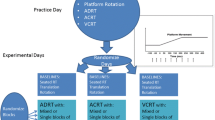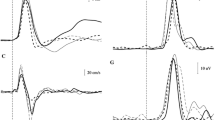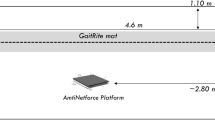Abstract
To date, little work has focused on whether cognitive-task interference during postural response execution is influenced by the direction and/or magnitude of the perturbation applied. Hypothetically, the increased difficulty associated with a backward loss of balance could necessitate increased allocation of cognitive resources to counteract destabilizing forces. The current study investigated these relationships using a paradigm in which individuals performed a cognitive task (auditory Stroop task during quiet stance; baseline condition). In certain trials, a translation of the support surface was concurrently evoked (magnitude: small or large; direction: forward or backward) which required a postural response to maintain balance. Ten healthy young adults completed four blocks of these experimental trials (26 randomized trials/block). Postural stability during balance recovery was evaluated using the margin of stability (MoS), while Stroop task performance was based on reaction time cost (RTC) and differences between experimental conditions. Results showed no effect of perturbation direction on RTC, but there was an observed MoS increase at peak extrapolated center of mass excursion following a small perturbation evoked concurrently with the cognitive task. No effect of cognitive-task performance was detected for MoS during stepping strategies (followed large perturbations). Instead, increased RTC were observed relative to the fixed base of support responses. In general, young adults adopted a “posture-first” strategy, regardless of perturbation direction, reinforcing the importance of cognition in the maintenance of upright balance.




Similar content being viewed by others
References
Bernard-Demanze L, Léonard J, Dumitrescu M et al (2014) Static and dynamic posture control in postlingual cochlear implanted patients: effects of dual-tasking, visual and auditory inputs suppression. Front Integr Neurosci. https://doi.org/10.3389/fnint.2013.00111
Bohm S, Mersmann F, Bierbaum S et al (2012) Cognitive demand and predictive adaptational responses in dynamic stability control. J Biomech 45:2330–2336
Bolton DAE (2015) The role of the cerebral cortex in postural responses to externally induced perturbations. Neurosci Biobehav Rev 57:142–155
Brauer SG, Woollacott M, Shumway-Cook A (2002) The influence of a concurrent cognitive task on the compensatory stepping response to a perturbation in balance-impaired and healthy elders. Gait Posture 15:83–93
Brown LA, Shumway-Cook A, Woollacott MH (1999) Attentional demands and postural recovery: the effects of aging. J Gerontol A Biol Sci Med Sci 54:M165-171
Chen HC, Schultz AB, Ashton-Miller JA et al (1996) Stepping over obstacles: dividing attention impairs performance of old more than young adults. J Gerontol A Biol Sci Med Sci 51:M116-122
Curtze C, Hof AL, Otten B, Postema K (2010) Balance recovery after an evoked forward fall in unilateral transtibial amputees. Gait Posture 32:336–341
Dijkstra TM, Schöner G, Gielen CC (1994) Temporal stability of the action-perception cycle for postural control in a moving visual environment. Exp Brain Res 97:477–486
Ebersbach G, Dimitrijevic MR, Poewe W (1995) Influence of concurrent tasks on gait: a dual-task approach. Percept Mot Skills 81:107–113
Etemadi Y, Salavati M, Arab AM, Ghanavati T (2016) Balance recovery reactions in individuals with recurrent nonspecific low back pain: Effect of attention. Gait Posture 44:123–127
Hasson CJ, Van Emmerik REA, Caldwell GE (2008) Predicting dynamic postural instability using center of mass time-to-contact information. J Biomech 41:2121–2129
Hof AL (2007) The equations of motion for a standing human reveal three mechanisms for balance. J Biomech 40:451–457
Hof AL, Gazendam MGJ, Sinke WE (2005) The condition for dynamic stability. J Biomech 38:1–8
Horak FB, Nashner LM (1986) Central programming of postural movements: adaptation to altered support-surface configurations. J Neurophysiol 55:1369–1381
Jacobs JV, Fujiwara K, Tomita H et al (2008) Changes in the activity of the cerebral cortex relate to postural response modification when warned of a perturbation. Clin Neurophysiol 119:1431–1442
Joseph Jilk D, Safavynia SA, Ting LH (2014) Contribution of vision to postural behaviors during continuous support-surface translations. Exp Brain Res 232:169–180
Kahneman D, Chajczyk D (1983) Tests of the automaticity of reading: dilution of Stroop effects by color-irrelevant stimuli. J Exp Psychol Hum Percept Perform 9:497–509
Kelly VE, Janke AA, Shumway-Cook A (2010) Effects of instructed focus and task difficulty on concurrent walking and cognitive task performance in healthy young adults. Exp Brain Res 207:65–73
Kerr B, Condon SM, McDonald LA (1985) Cognitive spatial processing and the regulation of posture. J Exp Psychol Hum Percept Perform 11:617–622
Lajoie Y, Teasdale N, Bard C, Fleury M (1993) Attentional demands for static and dynamic equilibrium. Exp Brain Res 97:139–144
Lamoth CJ, van Deudekom FJ, van Campen JP et al (2011) Gait stability and variability measures show effects of impaired cognition and dual tasking in frail people. J Neuroeng Rehabil 8:2
Little CE, Woollacott M (2015) EEG measures reveal dual-task interference in postural performance in young adults. Exp Brain Res 233:27–37
Maki BE, McIlroy WE (1997) The role of limb movements in maintaining upright stance: the “change-in-support” strategy. Phys Ther 77:488–507
Maki BE, McIlroy WE (2007) Cognitive demands and cortical control of human balance-recovery reactions. J Neural Transm (Vienna) 114:1279–1296
Maki BE, McIlroy WE, Perry SD (1996) Influence of lateral destabilization on compensatory stepping responses. J Biomech 29:343–353
Melzer I, Benjuya N, Kaplanski J (2001) Age-related changes of postural control: effect of cognitive tasks. Gerontology 47:189–194. doi: 52797
Morgan AL, Brandt JF (1989) An auditory Stroop effect for pitch, loudness, and time. Brain Lang 36:592–603
Nashner LM, Shupert CL, Horak FB, Black FO (1989) Organization of posture controls: an analysis of sensory and mechanical constraints. Prog Brain Res 80:411-418-397
Norrie RG, Maki BE, Staines WR, McIlroy WE (2002) The time course of attention shifts following perturbation of upright stance. Exp Brain Res 146:315–321
O’Connor CM, Thorpe SK, O’Malley MJ, Vaughan CL (2007) Automatic detection of gait events using kinematic data. Gait Posture 25:469–474
Patel PJ, Bhatt T (2015) Attentional demands of perturbation evoked compensatory stepping responses: examining cognitive-motor interference to large magnitude forward perturbations. J Mot Behav 47:201–210
Potocanac Z, Smulders E, Pijnappels M et al (2015) Response inhibition and avoidance of virtual obstacles during gait in healthy young and older adults. Hum Mov Sci 39:27–40
Redfern MS, Müller MLTM., Jennings JR, Furman JM (2002) Attentional dynamics in postural control during perturbations in young and older adults. J Gerontol A Biol Sci Med Sci 57:B298–B303
Redfern MS, Chambers AJ, Jennings JR, Furman JM (2017) Sensory and motoric influences on attention dynamics during standing balance recovery in young and older adults. Exp Brain Res 235:2523–2531. https://doi.org/10.1007/s00221-017-4985-5
Schaefer S, Krampe RT, Lindenberger U, Baltes PB (2008) Age differences between children and young adults in the dynamics of dual-task prioritization: body (balance) versus mind (memory). Dev Psychol 44:747–757
Siu K-C, Catena RD, Chou L-S et al (2008) Effects of a secondary task on obstacle avoidance in healthy young adults. Exp Brain Res 184:115–120
Weerdesteyn V, Schillings AM, van Galen GP, Duysens J (2003) Distraction affects the performance of obstacle avoidance during walking. J Mot Behav 35:53–63
Wellmon R, Barr-Gillespie AE, Newton R et al (2013) The effects of aging on the attentional demands of walking toward and stepping up onto a curb. Gait Posture 38:198–202
Winter DA, Patla AE, Prince F et al (1998) Stiffness control of balance in quiet standing. J Neurophysiol 80:1211–1221
Worden TA, Vallis LA (2014) Concurrent performance of a cognitive and dynamic obstacle avoidance task: influence of dual-task training. J Mot Behav 46:357–368
Worden TA, Vallis LA (2016) Stability control during the performance of a simultaneous obstacle avoidance and auditory Stroop task. Exp Brain Res 234:387–396
Worden TA, Mendes M, Singh P, Vallis LA (2016) Measuring the effects of a visual or auditory Stroop task on dual-task costs during obstacle crossing. Gait Posture 50:159–163
Acknowledgements
The authors would like to acknowledge funding provided by a NSERC Discovery Grant (awarded to LAV), Ontario Graduate Student scholarship and NSERC summer student fellowship (awarded to KAI) and Canadian Foundation for Innovation and Ontario Research Fund Research Infrastructure Grants for equipment. The authors would also like to thank Tim Worden and Rhianna Malcolm for assistance with experimental design and data collection and Dr. John Zettel for use of laboratory equipment.
Funding
This study was funded by Natural Sciences and Engineering Research Council of Canada (NSERC) Discovery Grant awarded to LAV (Grant number #261854).
Author information
Authors and Affiliations
Corresponding author
Ethics declarations
Conflict of interest
The authors declare that they have no conflict of interest.
Rights and permissions
About this article
Cite this article
Inkol, K.A., Huntley, A.H. & Vallis, L.A. Do perturbation-evoked responses result in higher reaction time costs depending on the direction and magnitude of perturbation?. Exp Brain Res 236, 1689–1698 (2018). https://doi.org/10.1007/s00221-018-5249-8
Received:
Accepted:
Published:
Issue Date:
DOI: https://doi.org/10.1007/s00221-018-5249-8




